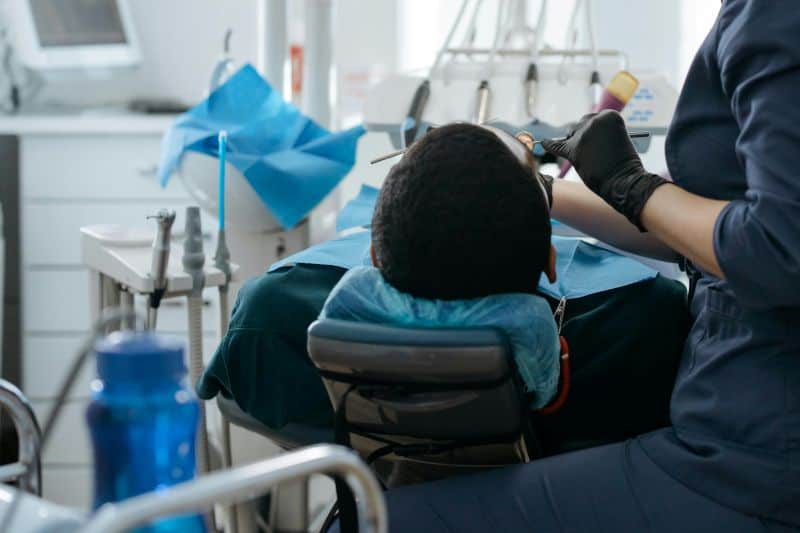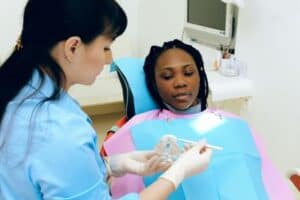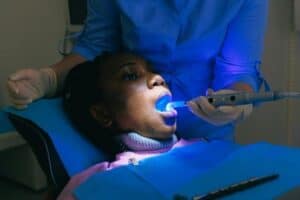
30 Sep Back-to-School Dental Tips for Kids and Teens
Back-to-School Dental Tips for Kids and Teens
As students transition from summer to school mode, mornings become more hectic, after-school activities increase, and dental routines can slip. But this is the time when oral hygiene is most important.
Oral health issues can lead to missed school days, poor concentration, and even social anxiety. According to the CDC, millions of hours are lost annually due to unplanned dental visits for school-aged children. By taking simple preventive steps now, parents can help their children avoid discomfort, embarrassment, and costly treatments later in the school year.
Let’s explore 21 essential back-to-school dental tips to help kids and teens maintain a healthy smile and the confidence that comes with it.
The Back-to-School Dental Checklist Every Parent Needs
One of the smartest ways to start the school year is by scheduling a dental check-up. A dentist can identify early signs of cavities, gum problems, or orthodontic concerns before they become major issues. Cleanings also remove buildup that regular brushing can’t eliminate.
It’s also a good idea to update your child’s dental records and verify that the school has current emergency contact information. If your child is starting at a new school, inform the administration of any dental devices like braces, retainers, or appliances, and provide insurance information for emergencies.

Daily Oral Hygiene Routine for Students
Brushing twice a day for two full minutes with a fluoride toothpaste remains the foundation of any good dental routine. Make sure your child is using a soft-bristled toothbrush and brushing in circular motions along the gumline.
Brushing alone isn’t enough. Flossing once a day removes plaque and food particles from between the teeth where brushes can’t reach. Encourage the use of floss picks or waxed floss if traditional floss is too tricky.
For teens, especially those with braces, adding an alcohol-free antibacterial mouthwash can offer extra protection by reducing plaque and helping with bad breath.
Nutrition Tips That Protect Teeth
What your child eats directly affects their dental health. Sticky candies, sugary cereals, and processed snacks can cause tooth decay, especially when consumed during the school day without brushing afterward.
Instead, aim to pack balanced lunches with fresh fruits and vegetables like apples or carrots, which naturally clean the teeth. Cheese is another great option since it helps neutralize mouth acids.
Avoid packing sugary drinks like sodas and fruit punches. Water is the best choice. If you’re sending juice, go for low-sugar, no-added-sugar options, and encourage drinking through a straw to minimize contact with teeth.
Braces, Aligners, and Life at School
Braces or aligners require extra attention during the school day. Kids with braces should avoid hard, sticky, or chewy foods like popcorn, gum, or caramel candies, which can damage wires and brackets.
Packing a small dental kit with a toothbrush, floss, and orthodontic wax can help your child manage minor issues at school. This can be a lifesaver when food gets stuck or wires start irritating the inside of the mouth.
Keeping aligners in their case when not in use is another key habit that prevents damage or loss during lunch or gym periods.
Bad Breath and Peer Pressure: A Real Concern
Halitosis, or bad breath, can be especially embarrassing for pre-teens and teenagers. Causes can include poor brushing habits, dry mouth, or eating strong-smelling foods.
To avoid this, make sure your child is brushing their tongue, drinking plenty of water, and brushing after meals when possible. Mouthwash can help neutralize odors, but it should not replace proper brushing and flossing.
Creating an environment where your child feels comfortable discussing hygiene and self-care issues goes a long way toward maintaining healthy habits and boosting self-esteem.
Dental Tips for Student Athletes
Kids who play contact sports are more prone to dental injuries. Investing in a well-fitting mouthguard can prevent chipped or knocked-out teeth and even help reduce the risk of jaw injuries or concussions.
Custom mouthguards made by dentists offer the best fit, but boil-and-bite versions available in stores are a solid alternative.
Hydration is also important. Water supports saliva production, which helps wash away food particles and acids. Sports drinks may seem convenient, but most are loaded with sugar and acid that erode enamel. Stick to water during games and practices.
The Role of Teachers and School Nurses in Dental Care
Educators and school nurses play a vital role in identifying and responding to dental issues. Parents should communicate any dental concerns or conditions their child may have, especially if they wear braces or have a history of oral health issues.
It’s helpful to provide the school with your dentist’s contact information, and in some cases, a dental emergency care plan. Teachers can also encourage water breaks and healthy snack habits that support dental wellness.
A proactive approach ensures your child gets the care they need quickly in case something goes wrong during school hours.
Dental Habits by Age: Elementary to High School
Dental needs change as children grow. Younger children between the ages of five and ten need supervision to ensure they’re brushing and flossing correctly. This is a good time to make dental care fun with music timers or brushing charts.
Pre-teens between eleven and fourteen are developing independence. They might forget to brush during busy mornings or resist flossing. Reinforce habits with electric toothbrushes or apps that reward consistency.
Teenagers fifteen to eighteen are preparing for life after high school. Help them learn to manage appointments, understand the risks of tobacco and vaping, and maintain their dental health even with a packed schedule.
Tech Tools for Tracking Oral Hygiene
Smart technology can be a game-changer for encouraging better dental habits. There are many apps available that remind kids to brush, track their routines, and even play music for the recommended two minutes.
Electric toothbrushes that connect to apps can help children and teens improve their brushing technique by providing real-time feedback. These tools make dental hygiene more engaging and less of a chore.
For families managing multiple routines, a shared family health app can help track dental visits, supply refills, and milestones like the removal of braces or wisdom teeth evaluations.
How to Handle Dental Emergencies at School
Dental injuries can happen anytime, especially on the playground or during sports. It’s important your child knows what to do in case of an emergency.
If a permanent tooth is knocked out, instruct your child to handle it by the crown (not the root), rinse it gently, and place it in milk or a tooth preservation solution. Then, get to a dentist immediately—ideally within 30 minutes.
Chipped or broken teeth, loose braces wires, or sudden toothaches should also be reported to the school nurse. Providing a mini dental kit in their backpack and informing school staff about any braces or dental devices will help them act quickly if an issue arises.
Back-to-School Dental Myths Debunked
There are several misconceptions about children’s dental health that can lead to poor decisions.
One common myth is that baby teeth don’t matter since they eventually fall out. In reality, decayed baby teeth can affect how permanent teeth develop. Another myth is that flossing is optional—it isn’t. It removes plaque brushing can’t reach.
People also think that sports drinks are better than soda, but both are highly acidic and harmful to enamel. And while mouthwash isn’t necessary for all children, teens especially benefit from it, particularly if they wear braces.
Lastly, braces aren’t just cosmetic. They can improve bite, speech, and even long-term jaw health.

FAQs About Back-to-School Dental Health
1. How often should my child visit the dentist?
Twice a year is the standard recommendation unless your dentist advises otherwise.
2. Is chewing gum at school okay?
Only sugar-free gum, especially with xylitol, can be helpful for reducing bacteria and freshening breath.
3. Should my child brush after lunch?
While ideal, it may not be realistic. Rinsing with water or using mouthwash can help maintain cleanliness until they brush at home.
4. Are electric toothbrushes worth it for kids?
Yes. They improve brushing technique and make the process more engaging, especially for kids who struggle with manual brushes.
5. Can my child’s diet really affect their teeth?
Absolutely. Sugary and acidic foods wear down enamel and cause cavities. A healthy diet is essential to dental wellness.
6. What should I include in my child’s dental emergency kit?
A toothbrush, floss picks, orthodontic wax, and mouthwash are great essentials for on-the-go care.
Conclusion: Set Up a Smile for Success
The beginning of the school year is the perfect opportunity to build or reinforce strong dental habits. By creating a consistent routine, packing tooth-friendly snacks, scheduling regular dental visits, and empowering your child with the tools and knowledge they need, you can help ensure that they face the school year with a healthy, confident smile.
Oral health isn’t just about avoiding cavities—it’s about supporting your child’s confidence, success, and well-being. And that makes it one of the most important school supplies of all.


Sorry, the comment form is closed at this time.